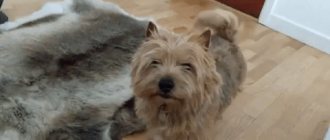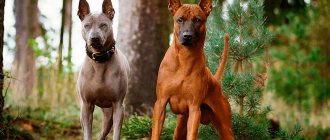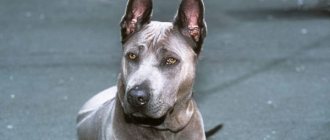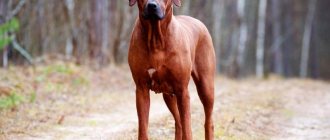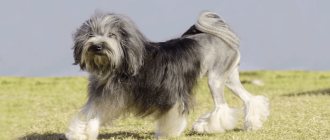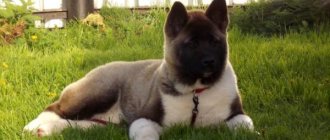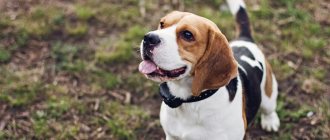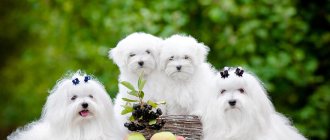In its entire history, South Africa has presented the world with the only dog breed recognized by the International Canine Association. She is a Rhodesian Ridgeback, originally intended for hunting lions. The extraordinary beauty of the breed attracts the attention of four-legged lovers around the world. The appearance, temperament, and inclinations of Ridgebacks make them unique, loyal dogs.
History of the origin of the breed
The beginning of the Rhodesian Ridgeback breed was laid in the 17th century, with the beginning of the Dutch colonization of South Africa (Cape Colony). The first “Rhodesians” were obtained by cross-breeding of European breeds (hounds, mastiffs, greyhounds, bloodhounds, pointers, terriers, retrievers, Great Danes) and aboriginal guard and hunting dogs, barely domesticated by the Hottentots. In pursuit of animals, including lions, they showed exceptional dexterity, for which they received the nickname “lion dog.”
Further selection of Ridgebacks was carried out separately, but made them a universal breed: the resulting animals guarded and hunted. Thus, the dogs of the peasants of South Africa looked more like mastiffs, and the animals of British farmers looked more like hounds. Both types of exterior have survived to this day.
In Europe, the Rhodesian Ridgeback became known in 1877. The breed was standardized in 1922 by Barnes in Zimbabwe, and in 1924 the standard was supplemented by the South African Kennel Union. Before this event, Rhodesian Ridgebacks were dogs that were very different from each other in appearance with a single unifying feature - the ridge on the back. Since then, the breed has spread throughout the world, and in the 1990s it appeared in Russia.
This is the only South African breed recognized by the FCI.
Application
In South Africa, Ridgebacks were used to hunt lions and other large animals.
In urban environments, he is tasked with guarding property and protecting the territory. Although even now they take him with them to hunt foxes, birds and other game.
Sometimes you can see these ridges in greyhound racing or agility (running on an obstacle course).
Sleepy baby ridge
Description of the breed
The first impression when looking at the Rhodesian Ridgeback is strength, endurance and swiftness. He is characterized by a harmoniously built, strong body without signs of excess weight and sagging skin, noble features, confident, intelligent behavior. His fat to muscle ratio is minimal, but his lean body is as strong as a Rottweiler.
The ridge, or ridge, is a strip of hair along the spine that grows in the opposite direction - a distinctive feature of the Rhodesian Ridgeback. Dogs of this breed are similar to hounds and are related to them.
Breed standard
Head:
- the muzzle is deep, strong,
- strong jaws with strong fangs, scissor bite,
- lips fit tightly,
- nose black or fur-colored (livernos), eyes dark or amber yellow,
- flat skull,
- ears are hanging, high set, medium, with a wide base, but a narrow round tip,
- there is no skin dewlap on the strong long neck,
- proportions: length of the skull (from the back of the head to the transition) = length of the muzzle (from the transition to the nose) = the distance between the ears.
Torso:
- strong back and lower back, with strong muscles,
- symmetrical ridge (ridge) from the shoulders to the croup,
- the chest is not wide, sky-shaped,
- lower edge of the chest at the level of the elbow joint,
- the tail is slightly curved (not a ring), thin, set neither low nor high.
Legs:
- straight, strong bones,
- elbows pressed to the body,
- round pads are collected into a compact lump.
Wool:
- the hair is short, not silky to the touch, but smooth, with shine,
- uniform color throughout the body, wheaten (from light to red shades), a little white on the chest and fingers is acceptable,
- A black mask is allowed,
- rare and unusual colors: spotted and striped, black and brown, silver, black and wheat.
Character and behavioral characteristics
“Rhodesians” are very devoted to the family (strong pack instinct), intellectually gifted dogs. But there is no carelessness, foolishness or unquestioning obedience in them; on the contrary, there is a lot of caution: they will first evaluate your every command and then carry it out. So, they may well ignore an invitation to go for a walk if it is raining heavily outside.
They value justice: insult, undeserved, from their point of view, punishment they will remember all their lives. Intelligence is the basis of the existence of Ridgebacks. Thanks to him, dogs are calm and non-conflict, do not give in to provocations, although they can stand up for themselves and their owner.
Puppies do not like monotony in games, they are very curious - they will definitely stick their nose wherever they can reach. Ridgebacks love dominance and comfort, so in the fight for the sofa you may well lose to him. To protect property or a person (child), they don’t even need to be trained - security qualities are in their blood. Therefore, he can scare your friend (if he doesn’t know him), even if he just touches your car.
Dogs of this breed are real intellectuals: they are not annoying, they can lie quietly on the sidelines for a long time, without bothering their tired owner, but during a walk you will have to work as hard as your pet. Long loneliness and the inability to “stretch” spoils the pet’s character, and the pet itself spoils the owner’s things.
Trainability
Thai Ridgebacks are highly trainable. Taking into account the psychological characteristics of the breed, when raising it, it is necessary to adhere to several principles:
- it is important to observe regularity and consistency of training;
- you need to train often, without long breaks;
- It is important to start training as early as possible;
- Ridgebacks are sensitive to respect for fairness, so the owner should never
- one cannot be inconsistent in punishments and rewards;
- This is a serious and dangerous breed with a developed protective instinct, so it is important to develop in the dog the skill of instantly responding to the owner’s command in any conditions.
Education and training
The main requirements are consistency, self-discipline and validity. Treat your “Rhodesian” evenly and calmly from puppyhood, do without physical punishment, dosing out severity in your voice, because he does not forget anything. Socialize your dog from an early age (6 months - 1.5 years), as an adult dog is too large and strong to be uncontrollable and aggressive.
Rhodesian Ridgebacks are excellent beaters, stopping but not attacking the animal. They are used in hunting and even in the security system of the Fort Knox military base. Canine activities that exercise the mind rather than the muscles are ideal for the Rhodesian Ridgeback.
Three periods of upbringing of a “Rhodesian”.
| Period | Puppy age, months | What to teach |
| 1 | 2 — 3 | eat on command, work with a toy, trust the owner’s hands, come to the command “Come to me!”, habit of a collar, leash, clicker, crate |
| 2 | 3 — 4 | specific commands (stunt and normative): “Stand!”, “Lie down!”, “Sit!”, “Near!”, “Place!”, switching and concentration of attention |
| 3 | 4 — 5 | socialization to other animals, people, urban environment, consolidation of commands in the face of distractions |
Finish training before your Ridgeback becomes a teenager; then the process will become more complicated for both you and the dog.
If you want to show your dog, go through exhibition training with it, teach it:
- work on the ring (a chain attached to the ears),
- show teeth
- let the testes (males) be felt,
- accept and maintain a show stance for at least a minute (the front legs are straight, parallel, the hind legs are slightly apart, the back is straight, the head is raised) - from 2 to 3 months,
- a calm walk to the left of the person and a smooth, moderate trot - from 5 to 6 months.
This breed is not suitable for novice dog owners; the owner himself must be balanced and consistent in order to reliably keep such a strong personality as the Rhodesian Ridgeback in check.
Advantages and disadvantages
- Pros:
- suitable for keeping in a city apartment;
- weak shedding and cleanliness;
- loyal character;
- silence;
- ease of care.
- Minuses:
- should not be let off the leash due to the instinct of pursuit;
- does not tolerate low temperatures and rainy weather;
- needs long and active walks;
- does not get along well with other pets;
- Not suitable for novice dog owners.
Hunting
Strong hunting instincts are enshrined in the genes of Ridgebacks. In their homeland, in Africa, they protected herds of livestock from wild predators, even lions. Accordingly, there they “learned” to hunt (pursue) any animal. This versatility has been passed on to modern representatives of the breed.
Not only field and forest game, raccoons and foxes, but also wild boars, moose, bears - hunting objects are quite feasible for them. They are used as hounds due to their excellent bottom sense. However, the upper sense of ridgebacks is also well developed. But they cannot freeze in a stance when they spot game; The Rhodesian Ridgeback is more likely to scare away a bird than to point it out to the hunter.
Where to buy and price
The average price of representatives of the breed is 20-30 thousand rubles. Puppies sold without papers may cost less, but purchasing them is risky. It is important to choose a trusted kennel that offers quality puppies; Ridge's Star, Moyo Savannah, and ARESVUMA have a good reputation.
If you want to get a Rhodesian Ridgeback, make sure you can allocate enough time for education, training, and walks. Then you will get a four-legged friend for all family members. The pet will not be picky about its maintenance and feeding, but it is important to follow all care recommendations.
Diseases and care
Ridgebacks, as an aboriginal breed, are naturally endowed with health and strong immunity, which, however, will not save them from common canine infections (adenovirosis, parainfluenza, plague, hepatitis, parvovirus enteritis, leptospirosis, rabies) if preventive vaccinations are not given on time .
They also have hereditary diseases:
Dermoid sinus: a canal in the skin of the back above the spine, leading to the vertebra and even to the dura mater of the spinal cord, formed in utero, removed surgically, associated with genes carrying the ridge;
Hip dysplasia: “looseness”, the cause of which is underdevelopment of the joint structures (acetabulum and femoral head), is transmitted with genes, aggravated by excess weight and unbalanced calcium and phosphorus feeding.
The short coat of the Ridgeback does not require complex care (combing, cutting, washing). These dogs do not have an undercoat, so they will be cold outside in winter. Dress your pet in warm clothes (blanket) before going for a walk. Mandatory care procedures:
- nail trimming,
- teeth cleaning,
- washing paws after walking.
You will have to walk with a “Rhodesian” for a long time (more than 3 hours a day) and actively. Due to the strong hunting instincts of this breed, walk dogs on a leash or away from the road. Runs and games in nature, where animals are not restrained by leashes, streets, fences and cars, have a beneficial effect on dogs.
Man and dog
First, let’s note who the Rhodesian is absolutely not suitable for:
- For those for whom this is the first dog,
- For families with small children,
- For those who are inclined to “humanize” their pet (in this case, the Ridgeback will grow up spoiled and disobedient),
- People with low levels of physical activity,
- And also for busy people who are rarely at home.
Ridgebacks can live in an apartment with proper training and early socialization, although a house with a fenced yard will suit them better.
They get along with children , but do not take into account very young family members, which, together with the size and strength of the Ridgeback, poses a potential threat to children.
Representatives of the breed will get along with cats and dogs that appeared in the house before them or grew up with them. On the street, the hunting instinct may prompt a Ridgeback to chase a barn cat.
Feeding
Ridgeback is not picky about the type of food (dry or natural), but it is imperative that it be complete. You cannot mix “natural” and “dried”: since these types of food are digested at different speeds, and this requires different amounts of enzymes and gastric juice.
Natural feeding
Puppies must receive a lot of animal protein (70 - 80% of the daily diet) and vitamins at the same time in the same place with the same food. Sources of animal protein - meat, fish, lactic acid products, eggs. Dogs digest monotonous food better. Do not feed your Ridgeback from your table, do not overfeed him or give him snacks!
The amount of raw meat is given at the rate of 100 g per 10 kg of dog weight. Offal (from 7 - 8 months) - twice as much. The rest of the diet consists of boiled sea fish, boiled turkey meat, fermented milk, egg yolk, cereals, vegetables, fruits and herbs.
Mistakes when feeding “natural”:
- overfeeding, food from the master's table,
- prohibited foods in the diet (pasta, potatoes, sweet, salty, hot, spicy, bones, peas, corn, oatmeal, dough, bananas, broths, raw protein),
- food is too hot or cold,
- lack of vitamins,
- sudden change of food,
- lack of fresh water.
Dry diets
It is better to feed your pet the same brand throughout its life, changing only the age category. Puppies are fed kibble soaked in water for up to 2 - 3 months. Be sure to provide clean water (change 1-2 times a day). Breeders advise choosing dry food from the brands Eukanuba, Acana, Monge, Flatazor, Bosch, Pro Pac, Pro Plan and other super premium brands. No additional vitamins are needed, but a Calcidee supplement wouldn't hurt.
Nutrition
You can improve your health with proper nutrition. This can be realized with high-quality premium quality industrial feed or natural dishes. The diet may include:
- lean meats;
- cereals (rice, corn, buckwheat);
- offal (rumen, udder, heart);
- sea fish fillet;
- vegetables (garlic, zucchini, pumpkin, broccoli, onions, carrots, white cabbage and cauliflower);
- fruits (pears, apples, grapes, bananas);
- fermented milk products (ryazhenka, kefir, yogurt, cottage cheese);
- microelements and vitamin supplements.
It is prohibited to feed dogs:
- bone broth;
- wheat cereal;
- potatoes and beets;
- boiled liver;
- minced meat;
- sweets;
- fatty foods;
- flour and bakery products.
Owners of four-legged pets need to control portion sizes, as these representatives of the breed are prone to obesity.
Premium dry dog food
Rating
Holistic dog food
Rating
Small breed dog food
Rating
Mating, pregnancy and childbirth
When choosing a mate for your dog, evaluate the exterior, health of him, his parents and grandparents. Before mating (~ 2 weeks in advance), both the bitch and the dog are treated for external and internal parasites and vaccinated. The health of both parents is a condition for healthy offspring.
Pupping in Ridgeback bitches lasts 60 - 64 days, fluctuation factors: age of the bitch, number of fetuses. Young females whelp earlier, low-fertility litters are born later.
| Critical periods, days after mating | What's happening | How to avoid problems |
| 1 — 7 | egg crushing, cellular synthesis | keep away from heat, hypothermia, radiation, chemicals, poisons, antibiotics and cytostatics |
| 16 — 18 | implantation of embryos into the walls of the uterine horns | protect from emotional and physical stress, do not change food and diet |
| 16 — 35 | placentation | eliminate vitamin deficiency A and E, prevent nervous breakdowns |
Signs of imminent labor:
- the stomach drops and becomes pear-shaped (last week of term),
- the mammary glands swell, colostrum is released (over several days),
- puppies move, can be easily palpated (in 7 - 10 days),
- Rectal temperature decreases sharply, from 38.5 to 36.5 - 37 degrees (per day).
Prepare an isolated, warm (28 - 30 degrees), dry room for childbirth, accustom the bitch to it 7 - 10 days before whelping. Cover the birthing area with waterproof diapers or film, equip it with a box of heating pads for newborn puppies, but it is better if already born puppies suckle from their mother during ongoing labor.
As they are born, mark the puppies with colored ribbons, register them in a table with the following columns: serial number, time, gender, birth weight, whether there is an afterbirth, features, color of the marking tape. Make a “nest” playpen out of boards so that the mother can get out of it, but the puppies cannot. Line the box with thick soft bedding. For walks, dress your bitch in a postpartum overall to protect her nipples from cold and dirt.
Health
On average, the Rhodesian Ridgeback can live 8-12 years. This is a dog with strong immunity and good health. In order for him to get sick less often and live longer, he needs to be routinely vaccinated against infectious diseases and treated against external and internal parasites.
Representatives of this breed are prone to the following diseases:
- Entropion - inversion of the eyelid can only be eliminated through surgery.
- Hypothyroidism is a pathology of the thyroid gland.
- Osteochondrosis is an inflammation of cartilage and joints, which is treated with injections and ointments.
- Bloating occurs due to poor nutrition and poor quality foods. If there is no timely help, the dog can die in a matter of hours.
- Deafness is in most cases congenital.
- Dysplasia - characterized by unbearable pain and lameness in the first stages. At the last stage, the dog may lose the ability to walk.
- Myelopathy is a neurodegenerative disease that leads to paralysis of the hind limbs.
- Dermoid sinus is a defect in embryonic development.
- Cataract is an eye disease that can cause partial or complete loss of vision.
How to choose a puppy
- study the classes of dogs (pet, breed, show) and choose a puppy that matches your intentions (whether you will participate in exhibitions or breeding);
- determine the desired gender;
- evaluate the health, appearance and character of your candidate, his brothers and sisters, mother;
- evaluate the conditions of detention and feeding;
- check the documents (puppy card, pedigree, veterinary passport), brand;
- ask when the bitch’s previous whelping was (if less than a year ago, then the puppies may be weak);
- Pay attention to the puppy who will be especially affectionate to you.
Ridgeback puppy price
The next point that worries everyone who wants to buy a purebred Rhodesian Ridgeback puppy is its price, which is not publicly available:
- “pet-class” puppies, suitable as a pet and excluded from breeding, cost about 20-25 thousand rubles;
- “breed-class” babies, who have good characteristics, but do not reach the title of “Champion” at exhibitions, cost between 30-45 thousand rubles;
- “show class” pets, which are the most prominent representatives of the breed with data as close as possible to the established standards, will cost approximately 70 thousand rubles.
Thus, an animal that has all the necessary documents and pedigree, with a full set of starting vaccinations, costs at least 70-75 thousand rubles. Of course, you can find a puppy at a more affordable price, but in this case the quality of the breed, as a rule, is not very high.
Important! The main influence on the pricing and cost of a Rhodesian Ridgeback puppy is the purity of the breed, the eminence of the animal’s parents and the availability of a full package of necessary documents.
SALUKI: DESCRIPTION OF THE BREED AND CHARACTER OF THE DOG
GAMPR: HISTORY OF ORIGIN AND CHARACTER OF THE DOG
KUVAS: HISTORY OF THE BREED AND CHARACTER OF THE DOG
LEONBERGER: HISTORY OF ORIGIN AND CHARACTER OF THE DOG
Owner reviews
“My Justa met all our expectations from a dog. My dad and I go cycling, she accompanies us everywhere. Our whole family is interested in auto tourism in Russia, and now she is also interested in it. In addition, she got along well with the child and the guinea pig. But in order to get more joys from our Giunta than problems, we went through OKD with her and even took prizes in this discipline many times. Yes, perhaps training is the most difficult thing on my mind with this dog.”
“I always wanted a large, loyal dog, but I only noticed the Rhodesian Ridgeback after walking with a friend’s dog. Stately, beautiful, she won our heart, and besides, there is no hair from her in the house, unlike the Bernese Mountain Dog. Well, we bought a puppy, Yana, from a kennel. She is still 5 months old, but there is no smell of the calm that much is written about. This is a controlled hurricane! A huge amount of time together, constant control and attention - this is what our dog needs, but it only makes us happy.”
“We trained and socialized our Perseus easily. True, he is afraid of the sharp sounds of firecrackers, but in all other respects the guard is no good. He is very beautiful and hassle-free in care and feeding, however, some foods cause allergies, but they can be excluded, right? And sometimes otitis occurs. Careful handling of a child came to him only with age; as a puppy, he would jump on his little son. But he still doesn’t like other males.”
Similar breeds
Externally, the Rhodesian Ridgeback is similar to some large and medium-sized hounds:
- the American Foxhound (a foxhound little known outside the United States; slightly smaller than the Ridgeback, more tolerant of small animals);
- English Foxhound (the most famous British hound, previously used for parforce hunting, now - for horseback riding);
- billies (large, light-colored (white in various shades or with markings) hunting dogs of French origin);
- large Anglo-French white and red hound (used to hunt large animals as part of a pack; it is difficult to make it a pet, it is also not suitable for exhibitions);
- Poitevina (kind-hearted, balanced, but stubborn when raising and training);
- Polish Ogar (affectionate, friendly dogs, prone to excess weight);
- Brundle Brakka (good jumpers, adapted for hunting in the mountains, have an excellent sense of smell);
- Hamiltonstövare (a very hardy breed with a keen sense of smell and eyesight, good at hunting alone);
- harriers (easy-to-guide hunters of hare, fox and wild boar);
and:
- Hungarian shorthaired Vizslas (elegant, extremely intelligent, friendly golden-red colored cops);
- Weimaraner (universal, obedient hunter with a high level of activity, clean, odorless).
Thai and Rhodesian Ridgeback: differences
| Rhodesian Ridgeback | Thai Ridgeback | |
| Classification according to ICF | Group V “Hounds and related breeds” (drooping ears) | Group VI “Spitz and primitive breeds” (erect ears) |
| Character, behavior | active, agile, strong hunting instinct | defender of the territory, hunting is not the main thing, “shadow of the owner” |
| Size | large | average |
| Color | wheat | black, red, blue, Isabella |
| Ridge | strictly saber-shaped with two “crowns” | any shape |
Character of the Rhodesian Ridgeback dog
Character (behavior) of the dog: dogs of this breed are endowed with a lively mind and self-esteem. They are friendly and affectionate towards their owners and indifferent to strangers. They rarely show aggression and do not bark in vain. By nature, the Rhodesian Ridgeback is patient, calm, and balanced. If his patience was tested, the dog would rather leave than lose his temper. For children, a large, strong animal becomes a good friend and protector.
In general, Ridgebacks are intelligent, self-confident, majestic, and intelligent. They quickly adapt to their environment and become attached to all family members. It is also worth noting that the strong-willed nature of such a pet will not allow it to be turned into a servant. Very often the dog shows stubbornness and independence.
Despite its loud, impressive bark, the Rhodesian Ridgeback dog is usually silent, barking only as a warning.
This strong, strong-willed breed requires a confident, demanding and experienced owner who can demonstrate leadership abilities. The dog should not feel weak, otherwise the owner will cease to be an authority for him.
The Ridgeback exhibits all its physical qualities to the maximum during the hunt. In some countries, it is a service dog used to patrol the streets and find drugs and explosives.
Photo
Briefly about the main thing
- The Rhodesian Ridgeback is a large, intelligent, independent, active dog, suitable for equally active people with a lot of free time.
- A distinctive feature of all Ridgebacks is a comb of oppositely growing hair along the back.
- Ridgebacks are difficult to train, they think about every command and are not averse to ordering a person around.
- The Ridgeback is an excellent hunter and an excellent guard.
- The breed is naturally healthy and hardy, but suffers from winter cold.
Tell us in the comments about your experience of keeping this breed. What difficulties have you encountered in the process of raising a pet?
Did you like the article? Share it with your friends on social media. networks. This will help them get useful information and support our project.
Appearance
Today, the Rhodesian Ridgeback is considered as a companion and hunter dog, and its exterior meets these requirements. The hound must be hardy, balanced, agile and not too heavy; Ridgebacks meet all these qualities. Against the background of working features, the breed is distinguished by its elegance and symmetry of build. The Rhodesian Ridgeback has a rather calm (for a cop) disposition; intelligence, balance, and restraint are noticeable in his behavior and gaze. Ridgebacks also behave reservedly towards unfamiliar people or animals; excessive aggression or friendliness is considered a fault.



